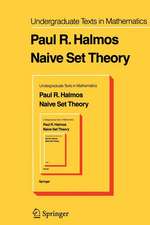Mechanical Theorem Proving in Geometries: Basic Principles: Texts & Monographs in Symbolic Computation
Autor Wen-tsün Wu Traducere de X. Jin, D. Wangen Limba Engleză Paperback – 14 apr 1994
Din seria Texts & Monographs in Symbolic Computation
-
 Preț: 393.52 lei
Preț: 393.52 lei - 20%
 Preț: 642.33 lei
Preț: 642.33 lei - 15%
 Preț: 640.71 lei
Preț: 640.71 lei - 20%
 Preț: 644.48 lei
Preț: 644.48 lei - 15%
 Preț: 640.06 lei
Preț: 640.06 lei - 20%
 Preț: 929.74 lei
Preț: 929.74 lei - 15%
 Preț: 643.34 lei
Preț: 643.34 lei - 15%
 Preț: 469.55 lei
Preț: 469.55 lei - 20%
 Preț: 591.17 lei
Preț: 591.17 lei - 15%
 Preț: 653.14 lei
Preț: 653.14 lei - 20%
 Preț: 348.89 lei
Preț: 348.89 lei - 20%
 Preț: 343.44 lei
Preț: 343.44 lei - 20%
 Preț: 341.30 lei
Preț: 341.30 lei - 20%
 Preț: 1160.88 lei
Preț: 1160.88 lei - 15%
 Preț: 702.24 lei
Preț: 702.24 lei - 20%
 Preț: 1460.04 lei
Preț: 1460.04 lei - 20%
 Preț: 652.07 lei
Preț: 652.07 lei - 18%
 Preț: 896.84 lei
Preț: 896.84 lei - 18%
 Preț: 1011.45 lei
Preț: 1011.45 lei - 15%
 Preț: 489.36 lei
Preț: 489.36 lei - 20%
 Preț: 1158.76 lei
Preț: 1158.76 lei - 20%
 Preț: 508.94 lei
Preț: 508.94 lei
Preț: 335.18 lei
Preț vechi: 418.98 lei
-20% Nou
Puncte Express: 503
Preț estimativ în valută:
64.13€ • 67.14$ • 53.07£
64.13€ • 67.14$ • 53.07£
Carte tipărită la comandă
Livrare economică 07-21 aprilie
Preluare comenzi: 021 569.72.76
Specificații
ISBN-13: 9783211825068
ISBN-10: 3211825061
Pagini: 308
Ilustrații: XIV, 288 p.
Greutate: 0.49 kg
Ediția:Softcover reprint of the original 1st ed. 1994
Editura: SPRINGER VIENNA
Colecția Springer
Seria Texts & Monographs in Symbolic Computation
Locul publicării:Vienna, Austria
ISBN-10: 3211825061
Pagini: 308
Ilustrații: XIV, 288 p.
Greutate: 0.49 kg
Ediția:Softcover reprint of the original 1st ed. 1994
Editura: SPRINGER VIENNA
Colecția Springer
Seria Texts & Monographs in Symbolic Computation
Locul publicării:Vienna, Austria
Public țintă
ResearchCuprins
Author’s note to the English-language edition.- 1 Desarguesian geometry and the Desarguesian number system.- 1.1 Hilbert’s axiom system of ordinary geometry.- 1.2 The axiom of infinity and Desargues’ axioms.- 1.3 Rational points in a Desarguesian plane.- 1.4 The Desarguesian number system and rational number subsystem.- 1.5 The Desarguesian number system on a line.- 1.6 The Desarguesian number system associated with a Desarguesian plane.- 1.7 The coordinate system of Desarguesian plane geometry.- 2 Orthogonal geometry, metric geometry and ordinary geometry.- 2.1 The Pascalian axiom and commutative axiom of multiplication — (unordered) Pascalian geometry.- 2.2 Orthogonal axioms and (unordered) orthogonal geometry.- 2.3 The orthogonal coordinate system of (unordered) orthogonal geometry.- 2.4 (Unordered) metric geometry.- 2.5 The axioms of order and ordered metric geometry.- 2.6 Ordinary geometry and its subordinate geometries.- 3 Mechanization of theorem proving in geometry and Hilbert’s mechanization theorem.- 3.1 Comments on Euclidean proof method.- 3.2 The standardization of coordinate representation of geometric concepts.- 3.3 The mechanization of theorem proving and Hilbert’s mechanization theorem about pure point of intersection theorems in Pascalian geometry.- 3.4 Examples for Hilbert’s mechanical method.- 3.5 Proof of Hilbert’s mechanization theorem.- 4 The mechanization theorem of (ordinary) unordered geometry.- 4.1 Introduction.- 4.2 Factorization of polynomials.- 4.3 Well-ordering of polynomial sets.- 4.4 A constructive theory of algebraic varieties — irreducible ascending sets and irreducible algebraic varieties.- 4.5 A constructive theory of algebraic varieties — irreducible decomposition of algebraic varieties.- 4.6 A constructive theoryof algebraic varieties — the notion of dimension and the dimension theorem.- 4.7 Proof of the mechanization theorem of unordered geometry.- 4.8 Examples for the mechanical method of unordered geometry.- 5 Mechanization theorems of (ordinary) ordered geometries.- 5.1 Introduction.- 5.2 Tarski’s theorem and Seidenberg’s method.- 5.3 Examples for the mechanical method of ordered geometries.- 6 Mechanization theorems of various geometries.- 6.1 Introduction.- 6.2 The mechanization of theorem proving in projective geometry.- 6.3 The mechanization of theorem proving in Bolyai-Lobachevsky’s hyperbolic non-Euclidean geometry.- 6.4 The mechanization of theorem proving in Riemann’s elliptic non-Euclidean geometry.- 6.5 The mechanization of theorem proving in two circle geometries.- 6.6 The mechanization of formula proving with transcendental functions.- References.
















